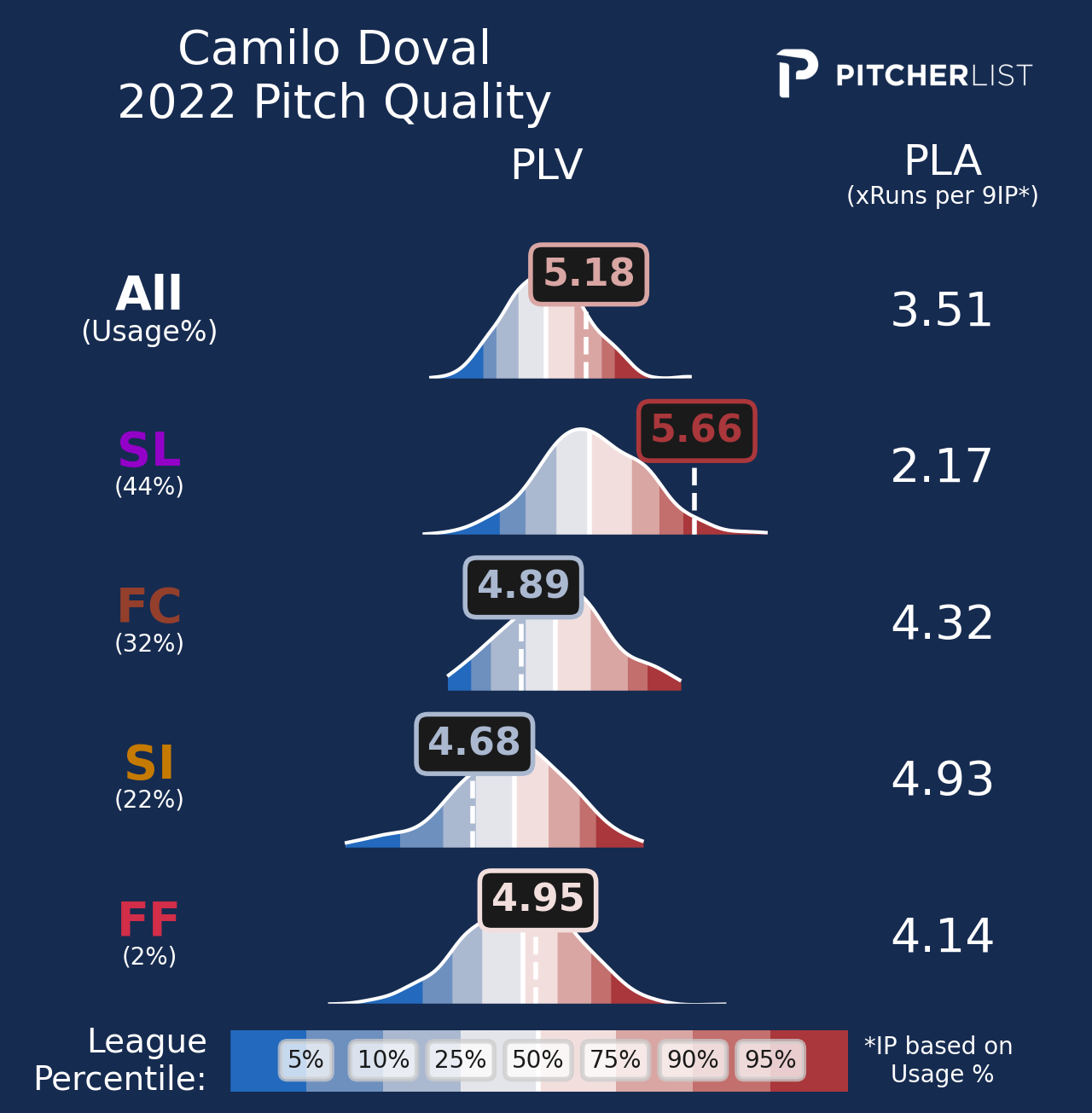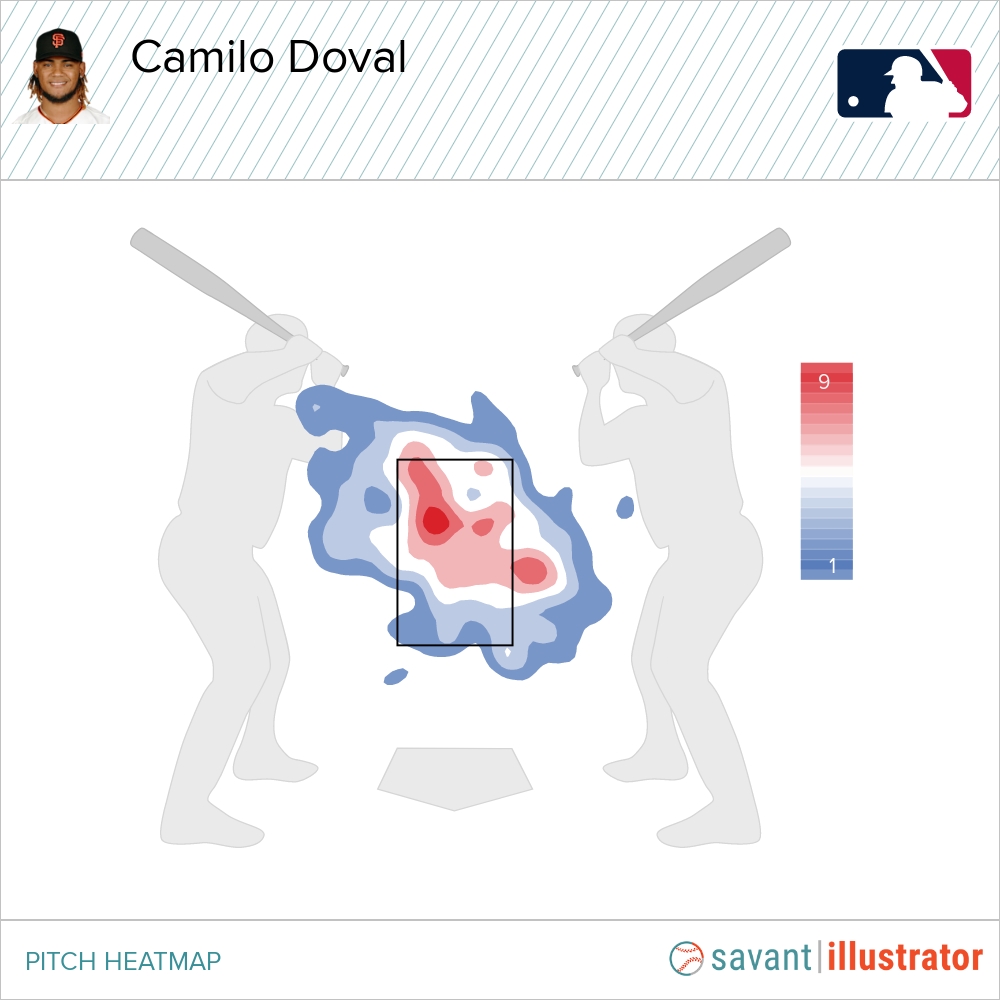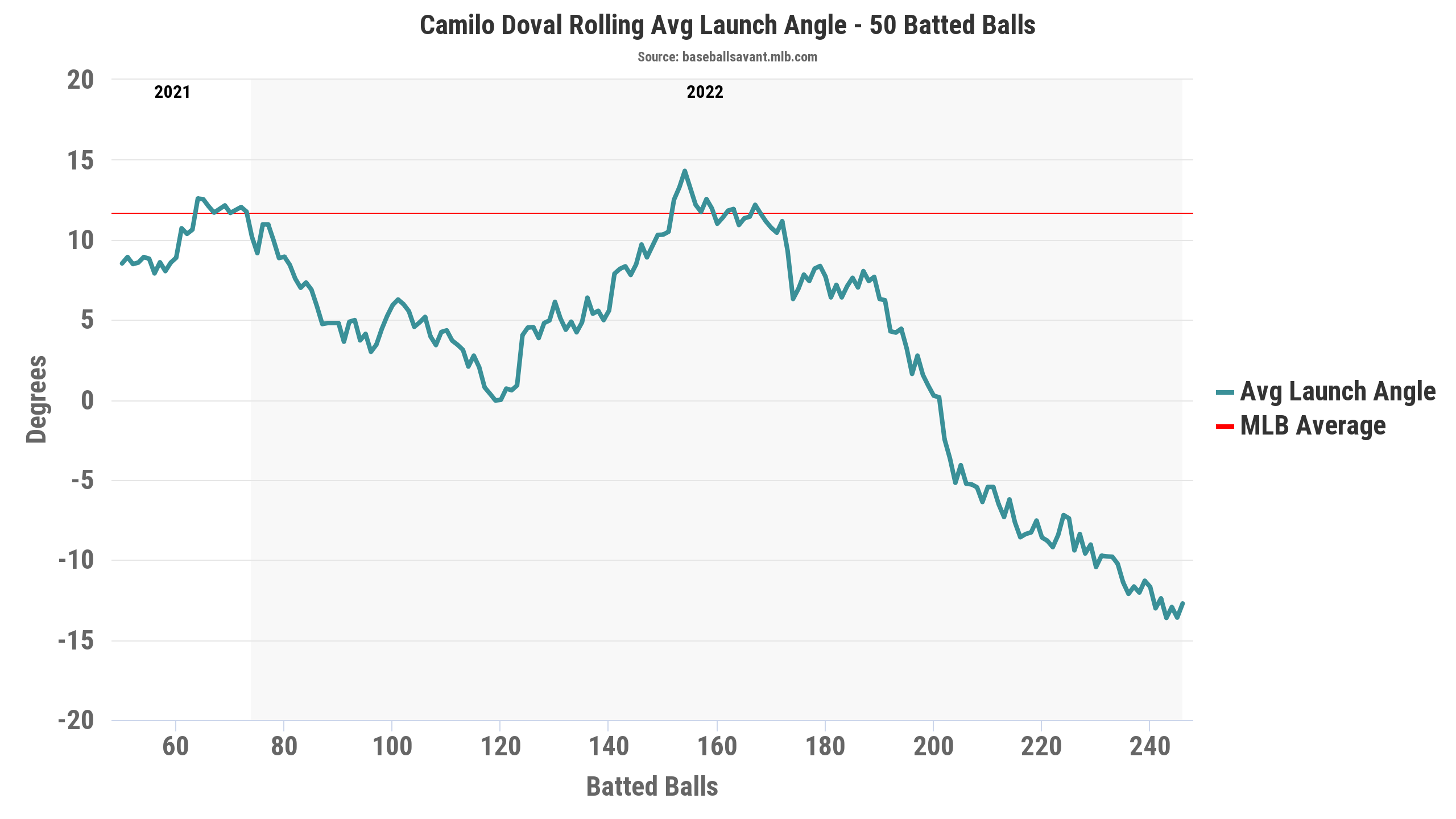Sometimes, I wonder if the San Francisco Giants have a top-secret pitching lab under McCovey Cove where they assemble superhuman pitchers, like Camilo Doval. Tim Lincecum was probably a freak accident where the engineers welded their biggest fastball onto an undersized frame, and it somehow worked. Down the hall, an intern misread the recipe and poured the entire franchise’s supply of clutch into the Madison Bumgarner mix.
Baseball sci-fi tangents aside, Doval is a relief pitcher on which the fantasy community seems bullish for a breakout this year. It’s no wonder, especially when we see him casually do things like this:
https://gfycat.com/anguishedshrillcrossbill
With electric stuff and quiet moxie, Doval has all the necessary tools to become one of the best closers in the game. Armed with a blazing fastball and wicked slider, the righty flamethrower has given the Giants organization a true heir-apparent at a position that has experienced extreme turnover since the dynasty days of the Core Four.
The Giants signed Doval as an 18-year-old international free agent out of the Dominican Republic in 2015. He worked his way through the minor league ranks with gaudy strikeout numbers, paired with some command issues. In early 2021, he struggled in his first cup of coffee in the majors. After being sent back down for a tune-up, Doval reemerged, teeming with confidence, to become a late-season hero for the 107-win team. He had a fantastic debut season as the full-time closer in 2022, racking up 27 saves. Like all young pitchers, bionic or not, there were some growing pains along the way. But Camilo Doval still has another gear to reach this season.
Stuff Don’t Lie
Doval was granted (or built, hmmm) a cannon for a right arm. His primary fastball is classified as a cutter, but it doesn’t look much like a cutter, thanks to its velocity. The pitch clocked in at an average of 99.4 mph, second only to Emmanuel Clase. To make matters worse for opponents, midway through the season, he decided to experiment with a sinker. He threw that at a ho-hum 98.4 mph on average – good for top 10 in MLB. The best thing of all is that the gas isn’t even his greatest weapon. That title belongs to his slider, which racked up these superb numbers last season while being thrown at a 43.6% clip.
Watch how it makes poor Stephen Piscotty, who happens to be one of Doval’s new teammates, look like a stand-in for David Spade in Benchwarmers.
https://gfycat.com/oblonguntidygar
Of his 80 strikeouts last year, 57 of them came courtesy of the slider. It was worth a staggering -17 run value, thanks to its above-average vertical and horizontal break. Those terrific numbers are backed up by his Pitch Level Value, which assesses pitch quality purely by its attributes, sans results. His slider proved to be one of the best pitches in the league last season, carrying his entire arsenal to a 75th percentile total PLV.

Doval possesses a deceptive windup with a long arm action, cocking his arm far back behind his head and effectively hiding the ball from the batter until release. Combined with his low three-quarters release, his slider is extremely tough to pick up. With a put-away pitch like this, how is Doval not yet a universally recognized top closer? On this same chart, notice that his fastball, despite its highlight reel potential, is surprisingly below league average. Let’s dive into how fixing this pitch could help Doval reach that next gear.
Fastball Follies
The first thing young pitchers realize when they break into the majors is that big-leaguers aren’t impressed by velocity. Professional hitters spend countless hours honing their ability to catch up to high heat. No matter how overpowering your stuff looks, a 100-mph fastball right down the pipe is likely getting smoked out the other way at 110. Doval is learning this first hand:
Doval’s unfortunate paradox is that while hitters fear him for his triple-digit heater, the prospect of it coming may be more daunting than the pitch itself. Doval seems aware of this during game situations, showing hesitation in trusting his fastball. Readers might remember that fateful duel against Cody Bellinger in the 2021 NLDS, where Doval lost the feel for it at the most inopportune time. He then threw four straight sliders, the last of which Bellinger punched into right field for the series-winning run.

A look at his cutter’s heatmap reveals that Doval’s undoing is command-oriented. His HiLoc% was a sizable 44.5%, so his intended approach is clearly to change the batter’s eye level with elevated cutters to set up the slider down. In execution, he is leaving many of those strikes over the heart of the plate and sailing balls arm side or yanking them down out of the zone. If he can fix these location mistakes, the whiffs will surely follow.
Digging deeper into the numbers, though, it doesn’t seem this pitch is quite as subpar as some of the metrics suggest. His BABIP on the cutter was nearly 100 points higher than expected last season and there were multiple examples of jam shots or bloops that a porous Giants defense failed to come away with. Batted ball luck doesn’t necessarily correlate with pitch quality, and Doval did get some unfortunate results that weren’t deserved.
Groundball Rock
There is another saving grace here for Doval, thanks to his newly developed third pitch. The previous version of Doval was a two-pitch pitcher, with both pitches sharing similar movement profiles. If his cutter failed him, he became relegated to a pure slider machine. White Castle specials are fun, but throwing a single speed repeatedly is an invitation for batting practice. The mid-season arrival of his sinker might just be the panacea. Look how his average launch angle improved drastically last season, coinciding with the introduction of the sinker.

Last season, Doval had a 56.4% groundball rate, which was a top-12 mark among qualified relievers. His newfound sinker was a big driving force, posting a 78% groundball rate. Pairing a pitcher with a K-rate above 30% at every level in the minors with an elite ability to get grounders? That is an unstoppable combination! These grounders hit against him aren’t worm burners either, as he was in the 94th percentile of the league in average exit velocity in 2022. A whopping 47.4% of the balls hit against him were topped, compared to the MLB average of 33%, showing hitters were simply pounding his pitches straight into the ground.
Hopefully, Doval ramps up his sinker usage even more next season, as it was a revelation for him down the stretch. The ability to throw pitches tailing away from lefties should help improve his splits significantly. You can see the sinker’s effectiveness displayed here as it breaks right out of Corbin Carroll’s swing path to ice the game.
https://gfycat.com/dampweepychupacabra
In a limited sample, the sinker was essentially a net-neutral pitch in terms of run value and the PLV was somewhat middling. Considering the pitch’s recent inception though, Doval should be able to improve his revamped arsenal even more with an offseason of refinement. His slider is so good that all he needs is a reliable fastball to set it up. Regardless, adding this new wrinkle in the ways he can beat hitters has enabled Doval to reach the upper echelon of closers. But there’s still one more area of improvement for him to truly take off.
Pound the Zone
Unless your name is Ricky Vaughn, a penchant for wildness is not something a pitcher wears as a badge of honor. Doval’s 10.5% walk rate is the one blight on his otherwise solid resume. It’s fair to wonder if he will ever develop amazing control, considering the heavy movement of his stuff compounded with his violent delivery. Pitchers with similar slingshot mechanics as Doval’s are typically more prone to losing their release point, so this may prove to be a feature rather than a bug. All the same, he could be even more dominant when he doesn’t have to pitch backwards. His first strike-rate of 54.2% last year was subpar, leading to far too many get-it-in situations. Count leverage was a struggle, as his Behind% (rate of pitches thrown in 2-0, 2-1, 3-0, 3-1 counts) was in the bottom third of the league. His Savant swing/take chart reveals room for improvement in throwing less non-competitive pitches in the waste zone.

Missing location is inevitable, but giving a batter easy takes as Doval did on 11% of his pitches is not a favorable outcome. This might explain why Doval’s WHIP was somewhat inflated last season. The numbers against him are predictably skewed in those “behind counts” as hitters are keyholing him, knowing he needs to get back in the count. If he can get into the strike zone early, his stuff is just too good in those spots. It all comes down to his approach in attacking each at-bat, which will improve with added experience.
The Clutch Factor
Doval’s most promising attribute is the one we have no way of measuring – confidence. Some pitchers have incredible talent and dominating stuff, but it falls apart once they’re handed the keys to the ninth inning. So far, Doval has not shown signs of wilting in the spotlight. We can see that in his leverage statistics. Leverage index is an indicator of how critical a situation is when a player is in the game. Among all qualified relievers, Doval ranked 9th in the league last year in highest average leverage index. Here is his performance in those situations:
Doval was at his best when thrust into the game’s biggest moments. In fact, one could argue his final numbers were even slightly tarnished by those less meaningful outings. Also, finishing the season strong has been standard procedure for Doval. Once autumn rolls around, he seems to reach another gear. He was dominant down the stretch last season, posting a 1.29 ERA across his final 14 appearances, grabbing nine saves and striking out 16. This comes on the heels of finishing the 2021 season with 16 scoreless innings. Having a closer that doesn’t crumble under pressure or break down in September is integral for both the fantasy and real life playoffs.
Time to Prove It
The sky is the limit for the new-and-improved Camilo Doval. Now all that’s left is for him to prove it. He goes into the 2023 season firmly entrenched as the full-time stopper. The Giants made some moves to bolster their bullpen, notably adding Taylor Rogers (the pitching lab apparently has a cloning facility now) to the late-inning mix, but that shouldn’t impact the closer hierarchy. With an upgraded squad behind him, look to Doval to be one of the better closers in the league, with excellent ratios and a strong possibility of eclipsing 30 saves.
Featured image by Kurt Wasemiller (@KUwasemiller on Twitter)

